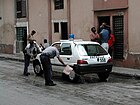National Revolutionary Police Force
| National Revolutionary Police Force Policía Nacional Revolucionaria | |
|---|---|
 | |
 PNR car, a Peugeot 106, being cleaned. | |
| Abbreviation | PNR |
| Agency overview | |
| Formed | 1959 |
| Jurisdictional structure | |
| Operations jurisdiction | Cuba |
| Governing body | Constitution of Cuba |
| General nature | |
| Operational structure | |
| Headquarters | Havana |
| Parent agency | Ministry of the Interior Committees for the Defense of the Revolution |
Crime rates in Cuba remain significantly lower than many other major nations worldwide, with Cuban police acting strongly against any crime, particularly in Havana. Fidel Castro commented in 1998 that "the war against crime is also a war against the imperialist enemy".[3] Information on murder and rape crime statistics for the country have never been released by the government, but theft was estimated to be 6,531 cases in 1988, or 62 per 100,000 population.[4]
Prisons
The
List of known prisons in Cuba:
- Combinado del Este Men's Prison
- Western Prison for Women
- Canaleta prison
- Villa Marista
Administration of the PNR
As with many countries, the PNR is under the control of the
While the Internal Order and Crime Prevention controls the PNR, which is responsible for day-to-day policing, the Security division of the Ministry of the Interior is responsible for crimes such as espionage, sabotage and offenses against state security.[4] All these divisions of the Ministry of the Interior and the PNR have been closely associated with the Cuban Revolutionary Armed Forces since 1959, thus the police uses the model those used by the Police of Russia with military ranks.
In addition, the PNR is supported by the Committees for the Defense of the Revolution (CDR), a police intelligence auxiliary police organization using la guardia, a nightly neighborhood watch. The CDR also handle issues relating to water and energy conservation, pet inoculation, and public health.[4]
Equipment
The PNR have a wide range of
U.S. sanctions
On 30 July 2021, the PNR (as an entity), its Director, Oscar Callejas Valcarce, and its Deputy Director, Eddy Sierra Arias, were added by the
Notes
- ^ UN Commission on Human Rights, 1988. Report by the Secretary-General. United Nations, Geneva.
- ^ "Cuba". War Resisters' International. Retrieved July 2, 2007.
- ^ "Police crack down on crime in Cuban capital". CNN. Retrieved July 2, 2007 – via Latin-American Studies.
- ^ a b c d e f g h i "Cuba". World Factbook of Criminal Justice Systems. Archived from the original on 2007-08-06. Retrieved July 2, 2007.
- ^ Rainsford, S. (May 1, 2013). "A Glimpse inside Cuba's Prison". BBC News.
- ^ "Russian Lada gets Chinese rival on Cuban roads". Reuters. 2009-09-29. Retrieved 2023-02-21.
- ^ a b "National Revolutionary Police". www.globalsecurity.org. Retrieved 2023-02-21.
- ^ "Treasury Sanctions Cuban Police Force and Its Leaders in Response to Violence Against Peaceful Demonstrators". U.S. Department of the Treasury. Retrieved 2022-01-17.
- ^ "Global Magnitsky Designations". U.S. Department of the Treasury. Retrieved 2022-01-17.
